
With their sensitivity to overheating, pikas are an indicator species for how climate change may affect mountain-dwelling wildlife/Photo courtesy of Shana Weber
Pikas, those tiny creatures that announce the intrusion of strangers to their territory with a squeaky bleat that sounds somewhat like "eeek," are known to suffer from warm temperatures. Now scientists studying these cousins to rabbits in the North Cascades National Park Complex say drier air conditions can be harmful, too, by stunting the growth of plants they rely upon.
Much has been written about the plight of pikas. Studies done back in 2015 looked at pikas and climate change at eight units of the National Park System. Those studies predicted a complex future for populations of the charismatic pika. Funded principally by the NPS Climate Change Response Program, the studies carried predictions through the end of this century that vary by park because of local conditions such as elevation, weather patterns, and genetic diversity.
In Grand Teton National Park in Wyoming, for instance, the scientists expect pikas to survive because of the park's wet and cold conditions. However, the outlook isn't so great at Rocky Mountain National Park in Colorado, where they expect higher temperatures to cause habitat suitability and connectivity to decline.
The temperature becomes a problem for pikas when it reaches 77 degrees Fahrenheit and stays there for longer than six hours. Now, research conducted in North Cascades found that decreased snowpack and lower air moisture may threaten pikas more than the temperature.
The problem revolves around "vapor-pressure deficit," which can be likened to air's aridity - higher VPD is drier. VPD governs the growth of many plants that pikas depend on for food, and controls cloud formation and snow. If VPD becomes higher, it will inhibit the growth of plants that pikas depend on for food, and will shrink snow packs which they use for insulation against extreme temperature. The snowpack also stores water until springtime, when it provides water for forage plants that pikas eat.
A team of researchers led by Aaron N. Johnston of the U.S. Geological Survey sought to understand how climate change, specifically changes in snowpack and VPD, is affecting pikas. In a paper published recently in the Ecological Society of America's journal Ecology, they related population abundances to weather and snowpack dynamics in the North Cascades. In the Pacific Northwest, a place with mild summers and prevailing cool, moist conditions, pikas occur at unusually low elevations including near sea level.
The study period included a year with record-low snowpack and high VPD, during the winter of 2014-2015, a data point that provided valuable observations of these variables' influences on the ecosystem. The researchers further studied the dynamics across differing elevations - low, middle, and high.
The results were surprisingly variable, with different dynamics acting over different elevations.
"We expected snowpack to be an important factor because it has many important ecological functions for pikas," said Johnston in a paper published by the Ecological Society of America. "The effect of VPD in winter was a big surprise."
At the lowest elevations, populations declined markedly. Unusually high VPD during the snow drought dried up forage plant species accustomed to moist conditions, and lack of food may have prompted malnourished pikas to forgo reproduction. Cold exposure did not appear to affect these pikas, where absence of snowpack is common because of generally warm temperatures.
At middle elevations, it was cold stress, not dry air, that had the biggest effect. Along a narrow elevation band, about 1200-1500 meters, pika populations lacked a strong snowpack in which to seek shelter and insulation from extreme cold. However, it was a dip in reproduction the following year, not pika mortality in a single winter, that caused the population abundance to drop. Pikas may have even resorbed fetuses in response to the cold stress of the snow drought.
At high elevations, where snow often persists for up to 7-9 months, forage came back into play as the important driver of abundances. Populations increased, having had sufficient snow cover for insulation despite a snow drought, and having benefitting from increased forage availability due to earlier snowmelt and a longer growth season for food. Pikas were able to consume and collect enough food to increase their health and ability to produce many offspring over the following winter.
Given the pervasive influence of moisture on the physiology of plants and animals, the authors find the lack of previous studies on animal responses to VPD surprising.
"Moisture is distinct from climatic factors of temperature and precipitation that are commonly used to explain animal distributions," Johnston said. "Incorporating moisture into species distribution models should improve ecological understanding of species and their responses to climate change."
Climate-indicator species like pikas provide a number of ecosystem services and play an important role in biodiversity. Pikas serve as a food source for a number of predators, including weasels, coyotes, and birds of prey. They are also ecosystem engineers - their foraging helps promote the diversity and distribution of various plant species and nutrients. Consequently, pika die-offs could have many lasting dire consequences for the environment and serve as a harbinger in forecasting potential climate change impacts on animal and plant life across the greater continental US.
As extreme events like snow drought continue to increase in frequency, how these events and their interactions with VPD will affect animal species remains largely unexplored. Support for continued research into climate indicator species such as the pika is critically important.



Add comment